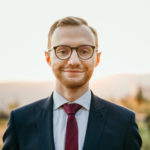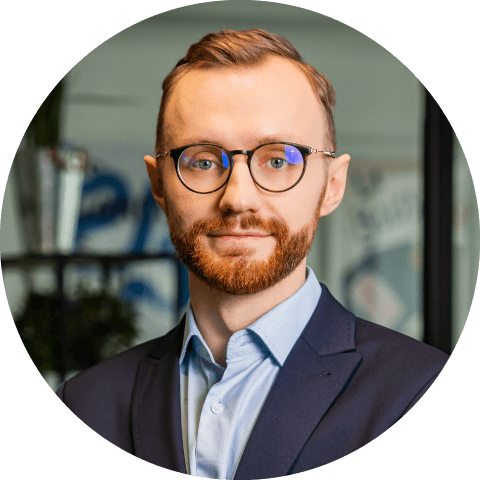AI technical support: Improve productivity, streamline operations, and save money
AI, machine learning (ML) and natural language processing (NLP) continue to dominate the front pages. These technologies and their applications in various industries are growing exponentially. One area where AI makes a massive positive change is technical customer support. AI technical support helps boost customer experiences and transform customer issues into positive interactions by providing instant support and accurate solutions. By quickly addressing customer issues, increasing response times, and offering proactive and comprehensive assistance, AI-driven support enhances satisfaction and builds trust, turning customer issues into positive experiences. This includes even the most specialised and technical sectors, where technical expertise is needed.
Whether you manufacture and manage wind turbines, run a bottling production line, or manage underground mining equipment, you should consider implementing AI solutions for customer support.
Technical support for software and hardware involves fully understanding the customer’s needs and context, analysing the situation using logs or application settings, identifying root causes and ultimately recommending the right solutions, delivering accurate and relevant answers, or dispatching technicians or human agents to fix the issue. AI can help with any of these steps.
Predictive analytics, ticket classification, advanced troubleshooting, AI-powered responses, 24/7 availability, and technician support are just some use cases that AI for tech support and customer service teams can handle. The great thing about AI in technical support is that it can be tailor-made and adjusted to specific needs to provide comprehensive assistance.
The growing need for AI technical support in specialised industries
As specialised industries become more complex, the demand for AI technical support is increasing. Businesses face high volumes of complex cases with customer questions and service requests, skill gaps in support teams, the need for faster support and 24/7 assistance, and many other obstacles. The list goes on. In the long run, they hinder the productivity of support, customer experience, and business performance.
Artificial intelligence is transforming the way businesses handle these obstacles, offering automated solutions that streamline support processes and continuously optimize performance. AI-driven chatbots, predictive analytics, and smart knowledge bases, or AI agents and assistants, can improve response accuracy and technical support operations in numerous industries. Since AI is highly customisable, it can work in various support channels and all three lines, as needed.
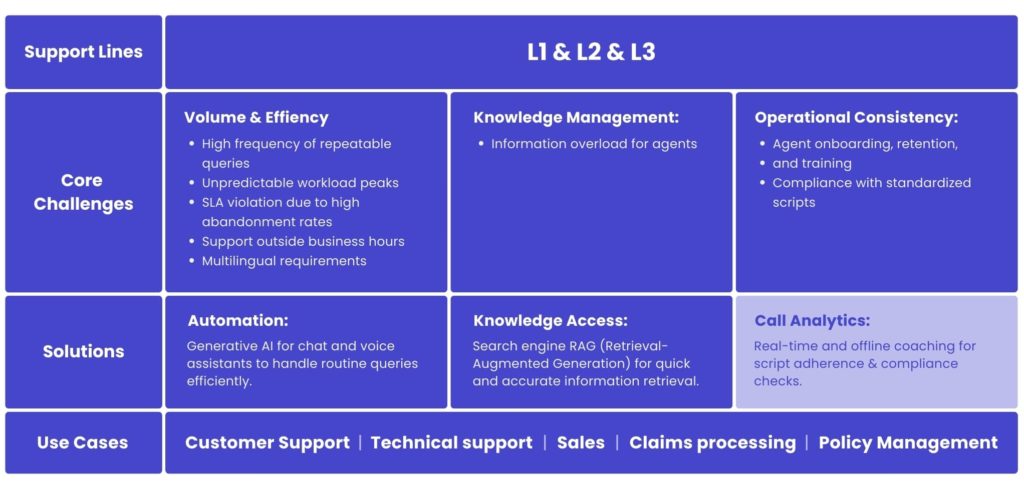
Better support with the holistic approach to AI technical support
The great thing about AI in technical support is that it can be tailor-made and adjusted to specific needs. Artificial intelligence can be integrated with different technologies and in multiple areas of tech support. This allows bridging gaps between various fields and creating systems that are adaptable, insightful, and capable of addressing complex challenges in technical support.
This means seamless collaboration between tools, such as chatbots, voicebots, knowledge bases, predictive analytics, or copilots to deliver efficient, accurate, and proactive tech support.

Below you will find some short case studies that illustrate how AI can enhance technical support and mitigate some issues.
Problem: Massive volume of customer requests
Technical support teams sometimes face an overwhelming volume of requests. This can have a terrible impact both on your customer and their customers – the end users. In cases of significant breakdowns, it can be challenging to mitigate such crises with limited resources.
Real-life scenario: A call centre was responsible for handling system restarts for electric vehicle (EV) charging stations. Whenever a charging station malfunctioned, drivers had to call a dedicated support number for assistance. This process was inefficient, leading to long wait times, delays in operations, and increased workload for support agents.
Solution: 24/7 support chatbot or voicebot. In high-pressure situations like this, AI-driven chatbots or voicebots can significantly ease the burden on support teams. Automating the restart process with an AI-powered solution can streamline issue resolution, reduce downtime, and save costs.
Problem: Inaccurate ticket classification and triage
Customer inquiries should be directed to the right teams. When ticket classification and routing are done manually, mistakes can happen. Urgent issues may be misclassified as low priority, tickets might be assigned to the wrong department, or critical cases could get stuck in a backlog, leaving your customer with an unresolved issue.
Real-life scenario: A manufacturing plant operator notices discrepancies in downtime classification for several production lines following a power outage. The system reports the shutdowns as “Operator Error,” but the operator suspects they should be categorised as “External Factors” due to an unexpected grid failure.
An analyst receives an email from the plant’s shift supervisor stating that workers attempted to restart the production lines at 8:00 AM but were unable to due to ongoing electrical instability. However, the system logs show the downtime starting at 6:00 AM and incorrectly attribute the cause to “Operator Error.”
Solution: Automated ticket categorisation. This can be handled by an AI-powered system that automatically reads emails, classifies events, and generates reports. Integration with ticketing platforms will ensure that classified incidents are logged in real-time, reducing the potential for manual input errors. This can save technicians time and effort.
Problem: Unnecessary dispatch of technician teams
This problem can have two causes: improper ticket classification or poor troubleshooting.
Misdiagnosing the issue can lead to an unnecessary technician dispatch. If the initial assessment fails to pinpoint the root cause accurately, the team may end up responding to a false alarm or a problem that could have been resolved with more thorough analysis. This, however, requires detailed and smart troubleshooting.
Real-life scenario: There was a problem on the bottle production line. A bottle fell over, and as the conveyor belt kept running, all the bottles behind it began tumbling down, smashing and causing chaos. The entire production line was in disarray. Instead of properly assessing the situation, the staff immediately assumed the issue was a serious mechanical failure and ordered a technician team to come out and fix the issue.
The real issue was poor troubleshooting. The production line had simply been disrupted by the falling bottle, but the staff didn’t take the time to properly assess the situation before calling for external help.
Solution: Chatbot handling simple and advanced troubleshooting. To avoid an unnecessary dispatch of technicians, you can implement an AI-powered chatbot that offers a powerful troubleshooting process of simple and advanced problems. These chatbots are designed to understand natural language, recognise user intent, access databases and logs to provide precise solutions to problems. In any other case, they’re smart enough to transfer a request to a human agent.
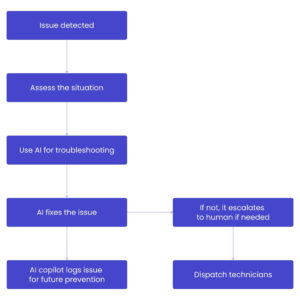
Problem: Lack of effective self-service resources
Research shows that more and more customers are eager to find solutions to their problems on their own. This shift in behaviour shows a significant issue for many businesses: the lack of effective self-service resources customers can access anytime they need.
This not only decreases customer satisfaction but also leads to increased workload for customer tech support teams.
Real-life scenario: A customer wants to buy paint but is unsure about which type of paint is best suited to their needs. They’re looking for a paint that is durable, easy to clean, and provides a smooth finish, but they aren’t sure whether to choose matte, satin, or gloss paint. They visit a paint manufacturer’s website to seek assistance, but all they get is a phone number which doesn’t respond.
Solution: Smart knowledge base. A great way to offer customer self-service is to implement an AI-powered knowledge base. It can improve customer support efficiency massively by leveraging internal knowledge bases and product documentation, so it can provide accurate and context-aware assistance.

Problem: Lack of proactive issue detection
Without proactive detection, problems go unnoticed until they escalate. Since there is no system in place to identify early warning signs, minor faults, such as equipment wear, software glitches, or process inefficiencies, go unnoticed. However, sometimes, some malfunctions can be predicted.
Real-life scenario: In a mining site, conveyor belts transport coal nonstop, operating in harsh, dust-filled conditions. Conveyor belts stop working regularly, but no one knows when it will happen.
Solution: Predictive analytics. An AI-driven monitoring system can analyse system, sensor, or user data to identify potential issues before they escalate into major disruptions. By detecting anomalies in real time, such as irregular performance patterns, increased error rates, or abnormal power consumption, the system provides early warnings to prevent failures. Automated issue classification helps prioritise responses, ensuring that critical problems are addressed as quickly as possible.
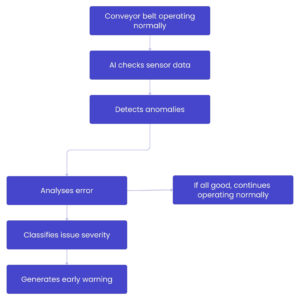
Other useful applications of AI in technical support teams
Artificial intelligence can also improve other areas of your business that influence the performance of your customer support teams : employee onboarding and knowledge management.
Smarter onboarding
Hiring and onboarding new support agents can be hard especially if you manage multiple products or services with various customer inquiries. New hires need to process a lot of information quickly. Navigating complex documentation, understanding troubleshooting steps, and adapting to different customer scenarios can be overwhelming.
AI-powered training programs
By utilising AI, we can create tailored training programs that onboard employees and ensure they gain the necessary expertise to perform at their best.
One of our clients faced a challenge with their technicians who were entering a new product domain. Despite their experience, these technicians struggled to grasp the specifics of the the new products. Our solution helps address this gap by implementing AI-based tests and assessments that continuously evaluate their knowledge, providing personalised learning paths.
Knowledge transfer
One of the biggest challenges in technical support is the aging workforce and the loss of expertise when experienced employees retire. Much of their knowledge goes undocumented and exists only in their minds. When they leave, critical troubleshooting skills, historical insights, and best practices risk being lost.
By implementing an AI-powered documentation tool, internal chatbots, or searchable knowledge bases, organisations can capture and retain knowledge. This allows new and existing team members to access expert insights even after senior employees have moved on.
Support copilots
Support copilots can be set up to provide real-time transcription, analysis, and intelligent assistance to support technicians, whether online or on-site. They not only offer instant access to troubleshooting guides, repair manuals, and best practices but also suggest possible failure causes, guide human agents with relevant diagnostic questions, and extract key insights during interactions.
Support copilots can create a real-time digital representation of a machine’s condition, helping technicians diagnose issues faster and with better accuracy.
See how we can streamline your operations with AI solutions
Do you need AI-powered customer support in your company?
AI is a versatile tool. This allows businesses to address a wide range of challenges, from online stores to factories. Implementing AI into your operations will streamline troubleshooting, automate ticketing, and enhance decision-making, reducing response times and minimising operational costs.
At Spyrosoft, we know AI inside out and will be happy to share our expertise to help you improve your business. Whether your focus is chatbots, voicebots, AI agents, smart knowledge bases, or other custom solutions, we tailor our services to meet your unique needs.
FAQ
AI in technical support refers to the use of artificial intelligence and machine learning technologies to automate or enhance customer service operations and tech support. This includes utilising tools such as chatbots, virtual assistants, knowledge bases, predictive analytics, and AI agents and copilots.
AI is used to automate responses, categorise and prioritise tickets, assist human agents, provide 24/7 support, and analyse customer behaviour for improved support delivery. It helps manage customer inquiries, provide instant responses, offer personalised recommendations, and even predict future issues based on historical data – significantly improving response times and overall customer experience.
Key benefits of using AI in technical support include faster response times, 24/7 availability, and the ability to handle large volumes of repetitive queries without human fatigue. AI-driven systems can also reduce operational workload by automating routine tasks and improving issue resolution accuracy through data-driven insights. This leads to a more consistent and scalable customer experience while freeing human agents to focus on more complex and strategically important problems.
AI can enhance all levels of technical support by automating and optimising different tasks based on complexity. In L1 support, AI-powered chatbots and virtual assistants can handle common queries, reset passwords, and provide basic troubleshooting. For L2, AI tools can assist human agents by analysing logs, suggesting solutions, and automating diagnostics. In L3 support, AI can support engineers by identifying patterns in large datasets, accelerating root cause analysis, and even predicting recurring system issues before they escalate.
About the author
